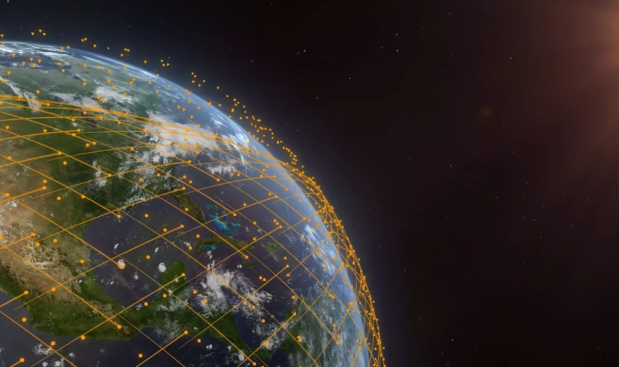
The future of digital connectivity is increasingly shuffling off the binds of its terrestrial coils.
This, as Amazon’s Project Kuiper satellite initiative has taken a key step toward establishing a globally connected optical mesh network powered by a space lasers system.
Since its successful launch and deployment of two prototype satellites with optical inter-satellite link (OISL) capabilities in October 2023, Amazon has been attempting to build an OISL ecosystem capable of moving and landing data anywhere via a mesh network in space, creating an end-to-end communications payload and network.
Now, those same two satellite prototypes have successfully transferred data at 100 gigabits per second over a distance of over 600 miles using infrared lasers in space.
“Amazon’s optical mesh network will provide multiple paths to route data through space, creating resiliency and redundancy for customers who need to securely transport information around the world,” Ricky Freeman, vice president of Project Kuiper division Kuiper Government Solutions, said in a statement.
The company says all of its upcoming 3236 Project Kuiper satellites will include such interlinks, forming a high-speed mesh network to route data around the world and providing broadband access to enterprise and public sector organizations no matter where they are, including potential customers like cruise liners in the middle of the ocean or aircraft making transatlantic flights.
Amazon isn’t alone in its goal to revolutionize digital connectivity by beaming space lasers jam-packed full of data between the nodes of strategically built satellite networks.
SpaceX’s rival Starlink system recently claimed to have more than 8,000 space lasers on its latest iteration of satellites, which began launching earlier this year.
But a little competition is good news for businesses and organizations down on earth, as OISL systems increasingly add to the momentum now driving innovation in every corner of our connected economy, which relies on an invisible layer of technology that lets systems securely communicate and makes new, connected experiences possible.
Read more: How Consumers Live In The ConnectedEconomy
Satellites with OISL capabilities are able to securely uplink data from nearly any location on Earth, transmit it through space via laser communications, and downlink it to their destination of choice.
They way the system works is that, rather than sending data between individual satellites and antennas on the ground, OISL lets satellites send data directly to other satellites in a constellation using lasers.
Each satellite in the network contains multiple optical terminals, allowing for multiple connections at the same time and forming high-speed cross-links that create a space-native mesh network, and increasing throughput while reducing latency.
Light travels faster in space than it does through other materials, like glass, allowing orbital laser mesh networks like the ones Amazon and SpaceX are building to move data 30% faster than Earth-bound methods like fiber optic cables.
Satellite operator Telesat, China’s state-owned GuoWang and Canadian startup Kepler, along with others, are all investing the use of OISL technology to power their own networks.
After all, beaming internet anywhere in the world from space at speeds that can’t be achieved on Earth is an attractive value proposition — and one that may spur an entirely new generation of innovations, as advances progress on a global scale versus being driven by certain centers of gravity.
See also: Why the Digital Transformation Needs a Reset
PYMNTS Intelligence has been tracking the shift to digital, worldwide, across 37 distinct activities since March of 2020 — consistently finding that connected devices and technology have shortened the distance between the customer and a business.
As PYMNTS CEO Karen Webster wrote, “Digital transformation is about the physical world becoming an extension of the digital world, not a bolt-on or a separate channel that is the stutter step to the analog processes that define business today. Digital must become a way of doing business, creating a fluid transition between the many digital and physical endpoints in which consumers and businesses engage.”
“The Industrial 4.0 revolution was based on digitization, and it’s starting to mature now,” Prateek Kathpal, president and CEO of SymphonyAI Industrial, told PYMNTS in an interview posted Dec. 1.
“The level of data-driven product and service innovation remains elevated and is building to new experiences,” MongoDB Chief Product Officer Sahir Azam told PYMNTS. “The typical geographic boundaries or physical boundaries are going away, and you can create these rich ecosystems.”
As satellite networks create new interconnected rails over which trillions of signals and transactions can travel, innovation across the business landscape will only continue to scale as real-time insights inform optimized approaches, transform workflows and help businesses further pierce the veil of opacity hovering around their disparate operations.
“You have to have a 360-degree radar because with digital transformation and digitization, traditional industry boundaries are blurred. Markets are blurred. The way you think things are organized is no longer true,” David Teece, executive chairman at Berkeley Research Group (BRG), told PYMNTS.
Data and data technologies will provide the information layer and connected tissue to power modern advances across areas like payments, artificial intelligence (AI), connected industry, and more.
After all, there are roughly 25 million software developers worldwide working on new digital experiences, many of which will be brought to market within an environment where radical transformation doesn’t start at home — it starts in space.